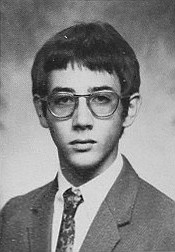- April 9, 2025
-
-
Loading

Loading

Contributor Robert Plunket sums up the life of Sarasota's Paul Reubens. The wacky comic genius known as Pee-wee Herman died July 30 after a six-year battle with cancer that he kept private. Plunket wrote about Reubens over the years and was friends with his mother, Judy.
How did Paul Reubens become Pee-wee Herman? What in his childhood planted the seeds of his future persona? And what part did Sarasota play in creating his wacky vision?
Paul’s journey to fame started when the Rubenfeld family moved to Sarasota in 1961. It was only 1,300 miles from their previous home in Oneonta, New York, but light years away in atmosphere.
After bleak and snowy upstate New York, Paul fell in love with the slightly exotic and kitschy glamour of Sarasota. “It was an incredibly exciting place at the time,” he told an interviewer much later in life, “and a cool place to grow up.”
Part of Sarasota’s allure was the circus. Ringling Brothers was still very much a part of the town’s life during Paul's childhood. He could see the most amazing performers in ordinary situations — retired Munchkins shopping in Publix. The Flying Wallendas lived nearby — with rigging set up in their backyard — and famed clown Emmett Kelly’s home was just a few blocks away.
For an impressionable young kid, it was a revelation. Paul was fascinated; his second movie "Big Top Pee-wee" is a love letter to these early memories.
In Sarasota, the Rubenfelds found the perfect house for the future Pee-wee to grow up in.
Just south of Harbor Acres on a street called Sparrow Circle, it is still remembered today as a great place to hang out: right on the bay, full of kids from the neighborhood, with the family’s latest mutt running about.

It was modern in design, rather Japanese-looking with shoji-type screens made of fiberglass that could be pulled back to open things up. There was a painting on velvet in the living room, indicative of the family’s slightly bohemian lifestyle. It was the forerunner of Pee-wee’s famous playhouse — full of fun, toys and gadgets, with all sorts of people dropping by.
Paul was lucky enough to have the perfect mother for a budding performer. Judy Rubenfeld was smart and outgoing. “She was the mother everybody wanted to have,” recalls one friend. She would often spend the entire day in her bathing suit.
Paul developed much of his comic timing from her. Judy could always come up with the perfect one-liner, even in a crisis. When the media circus surrounding Paul’s 1991 arrest for indecent exposure at the XXX South Trail Theatre was in full swing, she went into “mother bear” mode to protect him. Still, when she heard that ABC News' Diane Sawyer wanted an interview, her first response was: “How can I lose 20 pounds fast?”
The most important part of Paul’s early creative life was spent in the family room on Sparrow Circle, watching TV. He had an immediate connection with the performers he saw on the flickering screen. Re-runs of "I Love Lucy" were his favorite. He watched Lucille Ball over and over, absorbing her comic technique.
Howdy Doody was another favorite. “I cried the day the show went off the air,” he said. Paul dreamed of becoming a child star like Ron Howard, who played Opie on "The Andy Griffith Show." He even wrote a letter to Walt Disney, hoping to get a job somewhere in the Magic Kingdom.
A young artist needs training and mentoring and Paul was in the perfect place. Sarasota had the highly acclaimed Players Centre, which was and still is a “community theater," but one which held a special place in the town’s life. The work the Players did was excellent and everybody attended the shows. In sixth grade, Paul auditioned for "A Thousand Clowns" and got the part. He was immediately accepted into the town's extended theater family.
Paul was soon good enough to work at the Asolo Repertory Theatre, a professional regional theater famous for the excellence of its acting company. Once again, he found mentors. “I always thought he would end up a respected actor in rep,” leading lady Issa Thomas remembered.

When he wasn’t at the theater or Sarasota High School, Paul hung out with friends. They were the arty crowd at school and they had some wonderful times. They even invented their own dance: You stand on your toes, knees bent, and jab your hands to the front and then to the back, all to the tune of “Tequila.” It was a routine that would become world famous when Pee-wee performed it to ward off angry bikers in Tim Burton's 1985 film, "Pee-wee's Big Adventure."
But all that was still in the future. Paul was just beginning to put the pieces together. Then one night at the Asolo Rep, the magic finally happened.
He was in a play called "Life with Father," a 1939 comedy about a stern, demanding father and the four sons he has such trouble controlling. Paul played the youngest, most obnoxious one. It was a long run, several months, and as they continued performing Paul started to experiment with his part.
His instincts told him he should play it more cartoonish. So he began working on a voice — high-pitched and adenoidal. He’d try it out in certain places, refine it and try again. He finally thought he had it. So just as the play was in its closing week, he came out one night and delivered his last line in the voice. He knew immediately from the audience’s reaction that he was on to something.
And so, Pee-wee Herman found his voice on the stage of the Asolo Rep. Literally.
We miss you, Paul.